It is hard to believe that we are almost two years out from the onset of COVID-19. There is no aspect of the composites industry that has not experienced the ripple effects of the pandemic, and the ramifications are far from over. Nevertheless we’ve kept moving forward. From recycling to contactless in-situ temperture measurement, progress is being made.
CW took some time to reflect on how far we’ve come in 2021, and what you, our readers, found most interesting. Take a look at the top 10 most-viewed articles of 2021 below:
1. Why aren’t composites synonymous with infrastructure?
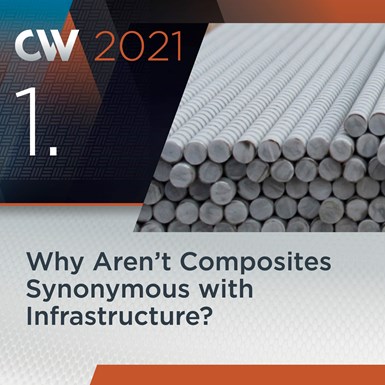
Coming in at #1, CW’s Editor-in-Chief, Jeff Sloan delves into a topic that is garnering a lot of attention in the U.S.: infrastructure. Under the Biden Administration, the U.S. is poised to invest heavily in this end market, thanks to composites materials’ ease of application, strength, durability and corrosion resistance.. Can the composites industry rise to the occasion?
2. Contactless monitoring of temperature and pressure inside composites
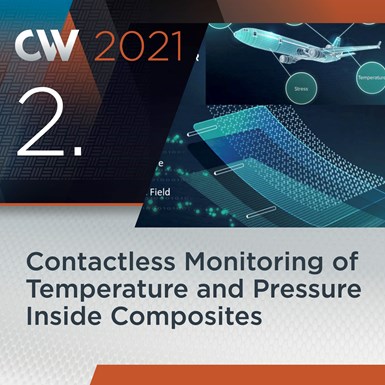
Microwire sensors have been around for quite some time. However, there has been a rapid rise in magnetic materials worldwide for a variety of measurement and sensing applications in the past few years. In this article, senior editor Ginger Gardiner takes a look at how magnetic microwires enable contactless measurement of temperature and pressure during cure and in service, and the huge potential it has in the composites industry.
3. Large-format 3D printing enables toolless, rapid production for AUVs
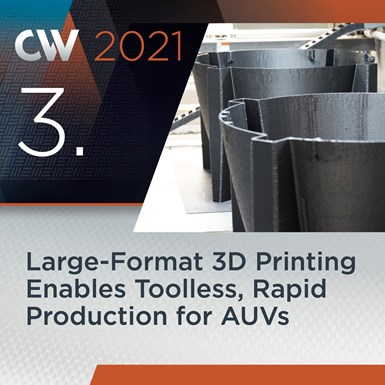
Autonomous underwater vehicles (AUV) are a type of unmanned robotic vehicle capable of traveling underwater without physical connection to or remote control from a human operator. Often outfitted with sensors and/or cameras, AUVs are used in various markets, including defense and ocean-based research. Energy companies have also used AUVs for offshore survey work to monitor existing oil and gas or offshore wind infrastructure, and to investigate areas for new development. More recently, Dive Technologies (Quincy, Mass., U.S.) started 3D printing prototypes of its composite autonomous underwater vehicles, but the AM process soon became the solution for customizable, toolless production.
4. Novel dry tape for liquid molded composites
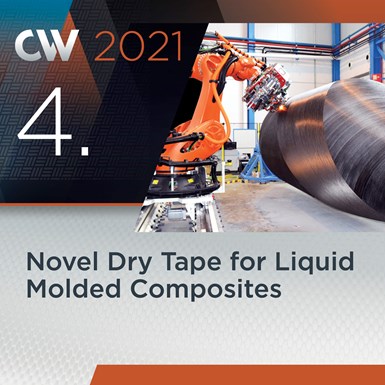
In this article, CW walks through MTorres’ (Torres de Elorz, Spain) patented dry fiber tapes and automated, high-speed production lines. Optimized for AFP and high resin permeability, the tapes allow infusion of thicker structures, while the production lines reportedly can convert 50K carbon fiber tow or 4800 tex glass fiber rovings at rates five to 10 times faster than state-of-the-art production by current tape suppliers.
5. Out-of-autoclave VBO rear spar, thermoplastic ribs target Wing of Tomorrow
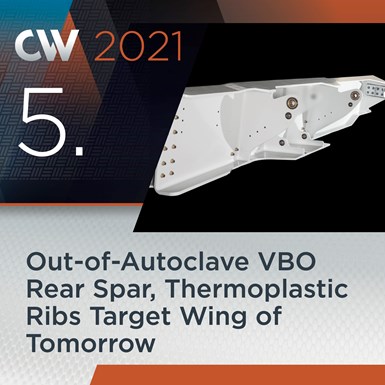
Airbus (Toulouse, France) is in the midst of a broad effort to work with aerocomposites fabricators on the development of out-of-autoclave (OOA) structures for the company’s Wing of Tomorrow (WOT) program. These structures are being delivered to Airbus in 2021 and will be assembled into a demonstrator wing that will be tested and evaluated for potential use in a next-generation single-aisle aircraft. When such a program might be announced is unknown, and the subject of much speculation, but the entire aerocomposites supply chain is positioning itself to be a part of the next generation of aircraft manufacturing, whether it’s for Airbus or Boeing, or both.
6. Wing of Tomorrow ribs: One-shot, thermoplastic, OOA consolidation
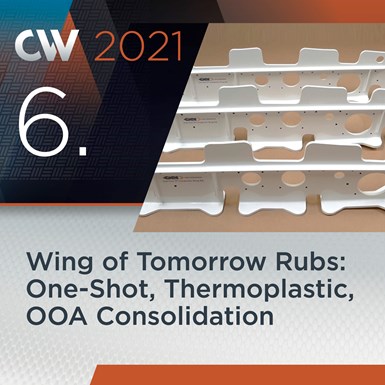
GKN Aerospace (Bristol, U.K.) has been very active in the WOT program, including the development of a wing spar demonstrator made via resin transfer molding (RTM) and four aluminum wing ribs. Another technology demonstrator recently delivered by GKN Aerospace involved the development of both a cost-competitive thermoplastic composite rib, and an innovative, modular press system for one-shot, OOA manufacturing to produce it. GKN Aerospace’s carbon fiber thermoplastic aircraft rib design accomplishes 45-minute cycle times, reduced weight and competitive costs via a customized press system.
7. Braided carbon fiber & resin transfer molding for complex composites
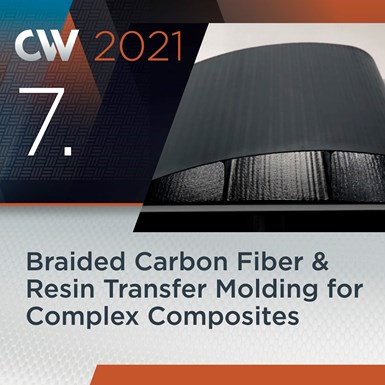
In this Digital Demo, Craig Jennings, CEO of Spintech Holdings Inc. (Dayton, Ohio, U.S.), introduces Hawthorn Composites (Xenia) and case studies of its high-value complex composites parts that are developed by deploying low-cost materials with resin transfer molding and novel manufacturing methods.
8. Recycling end-of-life composite parts: New methods, markets
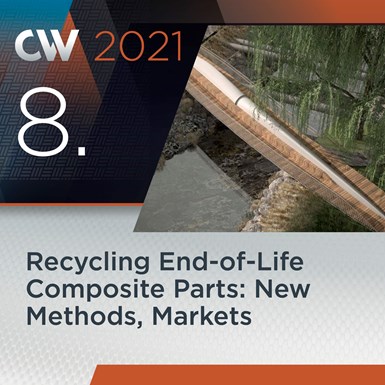
Many composites recycling methods work by burning off (pyrolysis) or chemically dissolving (solvolysis) the resins from a composite part, so that the fibers can be reclaimed and reused. Some promising recyclers and researchers are also working on methods for repurposing end-of-life (EOL) composite parts in their entirety. Reasons include retention of more of the original fiber and resin’s mechanical properties, reduction of processing costs or reduction of the carbon footprint of the recycling process. Associate editor Hannah Mason gives summaries of two such efforts.
9. Advancing the OOA infused wing box
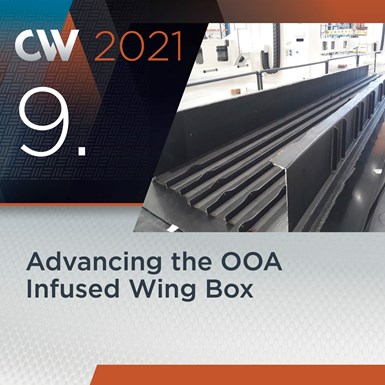
As the aerospace industry recovers from the COVID-19 pandemic, the previous push for high-rate production has pivoted to an urgent drive to reduce environmental threats to the planet and to people. Though these initiatives were ongoing pre-COVID, their emphasis is now heightened, as is the need for much lower cost to produce composite structures. The Clean Sky 2 pan-European aviation program has funded research and development in all of these areas and has significantly advanced a variety of fiber-reinforced composite technologies. Included in Clean Sky 2’s seventh call for proposals is the Airbus Defence and Space request for an innovative and flexible pilot plant to produce a highly-integrated wing box flying demonstrator using automated fiber placement (AFP) and liquid resin infusion.
10. Reprocessable, repairable and recyclable epoxy resins for composites
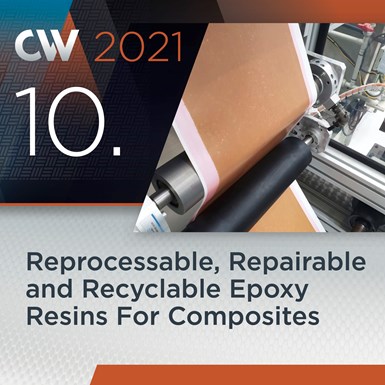
Started in September 2018, CIDETEC (Donostia-San Sebastian, Spain) began a 42-month project that will advance 3R composite thermoforming processes for high-volume production, cost-effective 3R composite repair and assembly via thermoset welding and improved adhesive bonding. These technologies will be showcased in two aerospace demonstrators: a composite fan cowl section with RTM skin and transverse stiffener adhesively bonded to a thermoformed longitudinal stiffener; and a section of a wing leading edge with thermoformed ribs welded to a skin made using same qualified RTM (SQRTM).
As 2022 begins, we are anticipating a bright future for composites. Along with that brings many opportunities to cover the most innovative aspects of the industry. If you have some of your own ideas about stories or topics we should consider covering, contact Jeff Sloan at jeff@compositesworld.com. We’re always interested in hearing from our audience. Cheers to a great 2022!
Related Content
Cryo-compressed hydrogen, the best solution for storage and refueling stations?
Cryomotive’s CRYOGAS solution claims the highest storage density, lowest refueling cost and widest operating range without H2 losses while using one-fifth the carbon fiber required in compressed gas tanks.
Read MoreWelding is not bonding
Discussion of the issues in our understanding of thermoplastic composite welded structures and certification of the latest materials and welding technologies for future airframes.
Read MoreNext-generation airship design enabled by modern composites
LTA Research’s proof-of-concept Pathfinder 1 modernizes a fully rigid airship design with a largely carbon fiber composite frame. R&D has already begun on higher volume, more automated manufacturing for the future.
Read MoreManufacturing the MFFD thermoplastic composite fuselage
Demonstrator’s upper, lower shells and assembly prove materials and new processes for lighter, cheaper and more sustainable high-rate future aircraft.
Read MoreRead Next
“Structured air” TPS safeguards composite structures
Powered by an 85% air/15% pure polyimide aerogel, Blueshift’s novel material system protects structures during transient thermal events from -200°C to beyond 2400°C for rockets, battery boxes and more.
Read MoreVIDEO: High-volume processing for fiberglass components
Cannon Ergos, a company specializing in high-ton presses and equipment for composites fabrication and plastics processing, displayed automotive and industrial components at CAMX 2024.
Read MoreAll-recycled, needle-punched nonwoven CFRP slashes carbon footprint of Formula 2 seat
Dallara and Tenowo collaborate to produce a race-ready Formula 2 seat using recycled carbon fiber, reducing CO2 emissions by 97.5% compared to virgin materials.
Read More






















